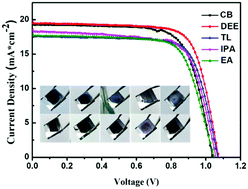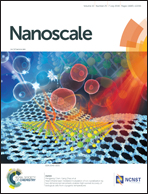Selection of an anti-solvent for efficient and stable cesium-containing triple cation planar perovskite solar cells†
Abstract
The perovskite layer is a crucial component influencing high-performance perovskite solar cells (PSCs). In the one-step solution method, anti-solvents are important for obtaining smooth and uniform perovskite active layers. This work explored the effect of various anti-solvents on the preparation of triple cation perovskite active layers. In general, anti-solvents with low dielectric constants, low polarity, and low boiling point are suitable for the preparation of perovskite films. Microstructural and elemental analyses of the perovskite films were systematically conducted by scanning electron microscopy, X-ray diffraction, and X-ray photoelectron spectroscopy. The photoelectric properties, carrier transfer, and recombination process in the PSCs were investigated using photocurrent–voltage characteristic curves and electrochemical impedance spectroscopy. Optimum performance was obtained when the anti-solvent was diethyl ether (DEE) and the ratio of the optimum amount of DEE to the volume of the precursor was 1 : 10. Meanwhile, we found that the partial replacement of formamidinium/methylammonium by cesium could increase the stability of the PSCs and enhance the power conversion efficiency from 15.49% to over 17.38%.



 Please wait while we load your content...
Please wait while we load your content...